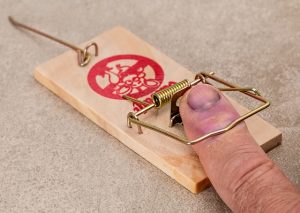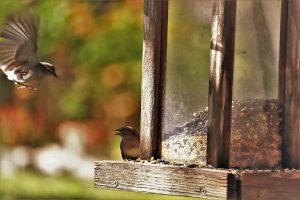Rats will enter your home because it offers protection, comfort, and food.
To stop this, you must know how to keep rats away from your home. After all, if they are not near your home, they won’t be able to get in!
Here are 8 tips that will help you achieve that.
8 Tips For Keeping Rats Away From Your Home
Keeping rats away from your home is not easy. You can do nothing to stop rats from getting close to your home completely for a start.
If you implement these tips, you vastly reduce the chances of a rat getting close to your home.

Seal the entrances

The most important thing you can do to stop rats from entering your home is to seal the entrances that a rat can use to gain entry. Although this isn’t what keeps rats away from your home, it does stop them from getting in, which is vital, right?
Rats only need a hole the size of their head to get through and destroy your home. You should first walk around your home and identify small holes, especially around cable entry points. Then, add a ball of wire wool around it to fill a gap effectively.
Once you have secured your property, you can move on to make the land around your home less attractive to rats.
Set traps around your home

If a rat wants to enter your land, it will. To ensure it does not get further than the perimeter, add some traps and check them regularly.
When catching rats, it is worth considering which trap to use in your yard. The options are as follows:
- Snap Traps – Work well, but there is a danger of catching other wildlife.
- Door Traps – These tempt the rat and keep it trapped until you check.
- Electric Traps – Similar to the door traps, these electrocute rats when they enter.
- Poison – Has no way to discourage other wildlife from eating it. Also, if a rat takes the bait and is eaten by a predator, it will be poisoned.
My preference is to go for the door traps with poison as bait. That way, the rat will take the bait but will be trapped.
Check the trap every few days and clear out any dead rats.
Get a cat

Cats are an excellent rat deterrent! Not only will their scent warn rats away from your property, but those who are still brave enough to enter will also be chased away by your cat.
Set up a few comfortable places around your property for your cat to rest. Cats are very territorial creatures and will ensure their domain is marked. If you want to keep rats away from your home, the smell of a cat will do the job, especially if they are present during the nighttime.
If you have set up some comfortable areas for your cat, it will include those in its territory and mark them as needed.
Cut down hiding places.

Rats like to travel undercover. They will only venture into wide-open spaces if they need to. Bushes, plants, and trees offer some excellent cover that rats will use to travel and keep out of the way of predators.
The more a rat travels in an open space, the more exposed to predators from above, such as owls and other birds of prey.
Your job is to check for overhanging trees and bushes near your home. Rats are excellent climbers who can quickly scale a tree and access your house through the roof.
Cut these access points down to reduce the chances of your house being used to host a family of rats!
Get an electronic rat deterrent.

Ultrasonic Rat deterrent devices can work. After discussing the success rate with several users, the feedback was positive and negative.
Some users were very pleased with the devices, and some reported that they did not deter rats effectively. I am not convinced that the devices were being used correctly or that the users had enough devices.
It is worth considering covering more of your house with these devices and even covering some points in your yard.
Rats are clever and will avoid areas covered by an ultrasonic device. If your entire house is not covered, they will find a way to enter and set up a nest.
Fill Your Cavities

One of the most common places for a rat to nest is in the cavity of your walls. Once they find a hole small enough to crawl through, the first place they get to is the cavity.
They use the cavity walls as a nesting spot and an excellent rat run that enables them to navigate through your home while offering superior protection from predators.
By filling your cavity walls, you can make it difficult for a rat to enter your home. It can be a costly task that certainly requires the skills of a professional. However, if rats regularly invade your home, it is worth considering it as an option.
There is also another excellent benefit to filling your cavity walls. For example, if rats are using them as a rat run or as a nest, there is a possibility that a rat can die. You will notice the odor of a dead rat within days.
Hunting for a dead rat in your home is no easy task, and it is even more difficult if it is in the cavity walls. Therefore, you will need to pay a professional to hunt it down and remove the body.
Store food correctly

If you store food in your yard, ensure all food items are stored correctly.
Rats can chew through many items; they need to gnaw to constantly keep their teeth at a decent length.
Do not store food in
- Plastic Bags
- Plastic Containers
- Woven Bags
- Wooden Boxes
Do store food in
- Strong, sealed metal containers
- Glass Containers
Along with security and comfort, your home is an excellent food source. A rat will navigate your home during the early morning hours searching for food, so you must store food correctly.
Remove bird feeders

Very similar to the tip above! Rats enter your property looking for food. Now that you have stored all of your food correctly, the next step is to remove the bird feeder.
If you have a bird feeder and do not want to remove it, clear it of food at night or remove the feeder until the morning. Rats will look for food during the night and into the early morning hours. Removing the bird feeder will reduce the available food for them.
Understanding their behavior helps keep them away
When it comes to keeping rats away from your home, it’s important to first understand the habits and behaviors of these pesky critters. After all, you can’t outsmart a rat if you don’t know how it thinks!
So, let’s dive in and take a closer look at the habits and behaviors of the two most common rat species found in homes: the Norway rat and the roof rat.
First, we have the Norway rat, also known as the brown rat or sewer rat. These burly beasts can grow up to 18 inches long, including their tail, and can weigh up to a pound. They’re typically found in lower buildings and are known to burrow in soil or under concrete.
Norway rats are also known to be excellent swimmers, so don’t think just because you live in a flood-prone area, you’re safe from them!
Next, we have the roof rat, also known as the black rat or ship rat. These sleek and slender rats can grow up to 16 inches long and weigh around 6 ounces. As the name suggests, they’re known to hang out in high places, such as attics and trees.
They’re also known to be expert climbers, so don’t think just because you live in a one-story home that, you’re safe from them!
Now that we know a little about the physical characteristics of these two rat species, let’s look at their behavior and habits.
Both Norway rats and roof rats are social animals and can live in large colonies. They’re also known to be nocturnal creatures, so if you’re hearing strange noises at night, there’s a good chance it could be a rat.
Both species are also known to be omnivores, meaning they’ll eat pretty much anything, including fruits, vegetables, meats, and even other rats.
One of the most important things about rats is that they constantly search for food and shelter. It’s estimated that a single pair of rats can produce up to 15,000 descendants in just one year (source: “Rats” by Dr. Robert M. Timm, University of California Agriculture and Natural Resources). So, if you want to keep rats away from your home, it’s important to ensure you’re not providing them with the things they need to survive: food, water, and shelter.
In conclusion, understanding the habits and behaviors of rats is key to keeping them away from your home. By knowing what they look like, where they like to live, and what they like to eat, you’ll be better equipped to take the necessary steps to protect your home and loved ones from these pesky critters.
Conclusion
These 8 tips will certainly help keep these rats away from your home!
When asking why rats enter your home, the answers are pretty simple. Warmth, food, comfort, and protection.
While there is no best way to keep rats away from your home, using all these methods greatly reduces your chances of a rat infestation, and that is the aim.
Armed with that information, you can ensure your home is not a welcome place for rats!
Good luck
References:
- “Rats” by Dr. Robert M. Timm, University of California Agriculture and Natural Resources
- “The Norway Rat” by the University of Missouri Extension
- “Roof Rats” by the University of California Agriculture and Natural Resources








